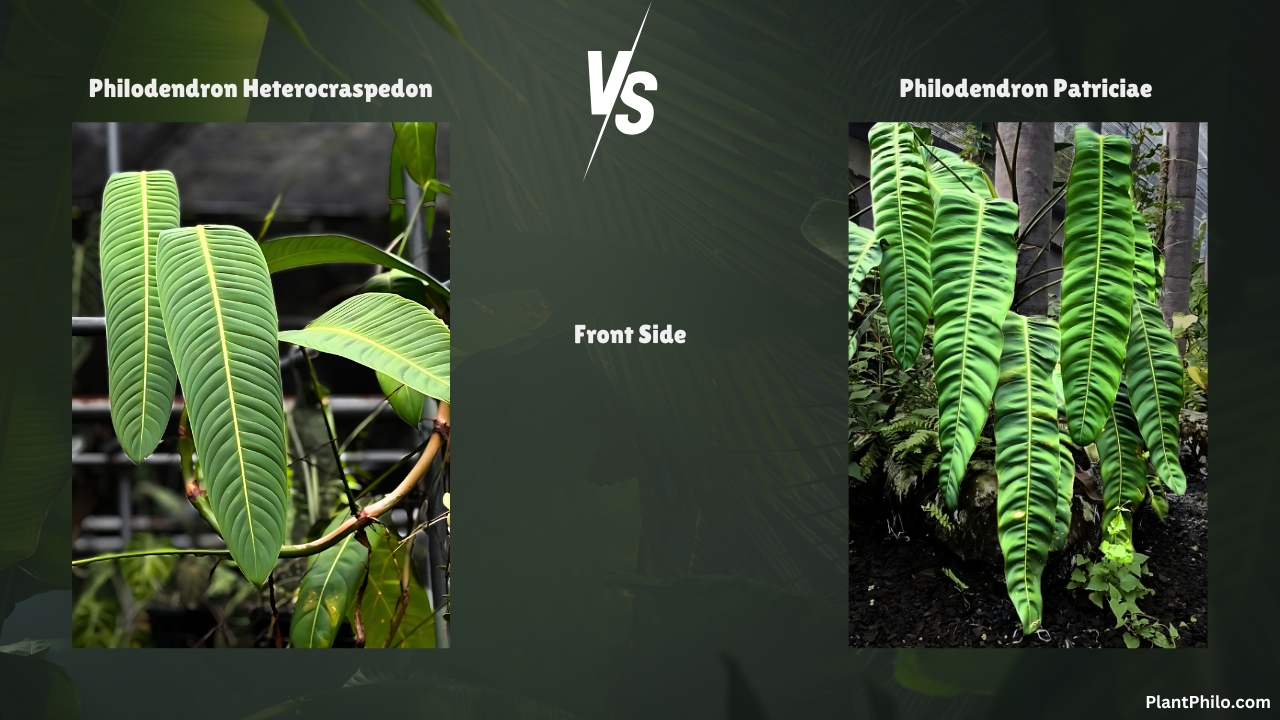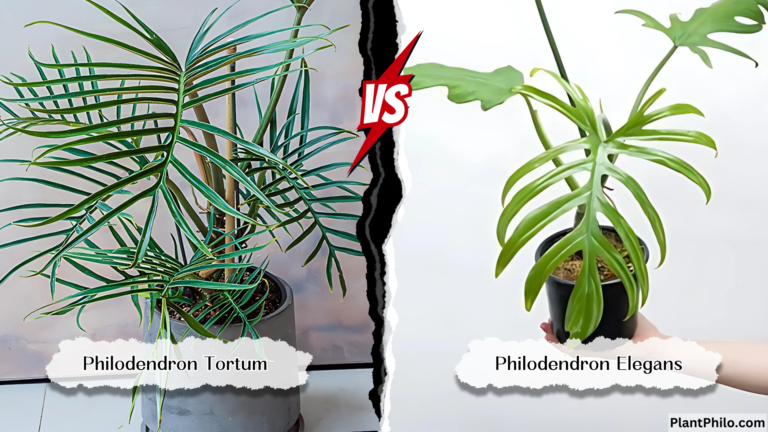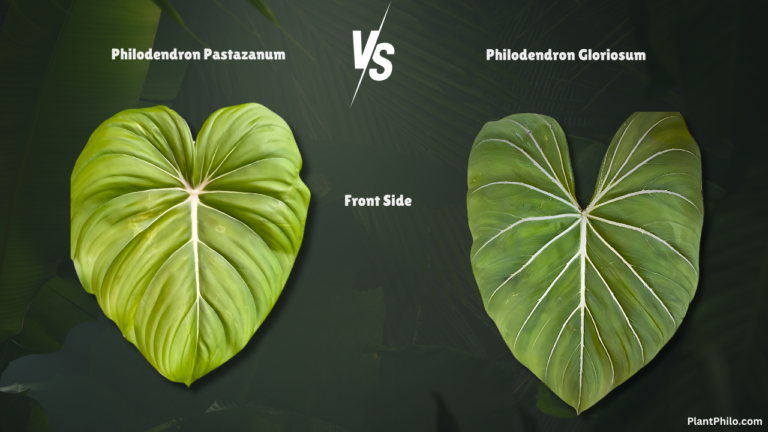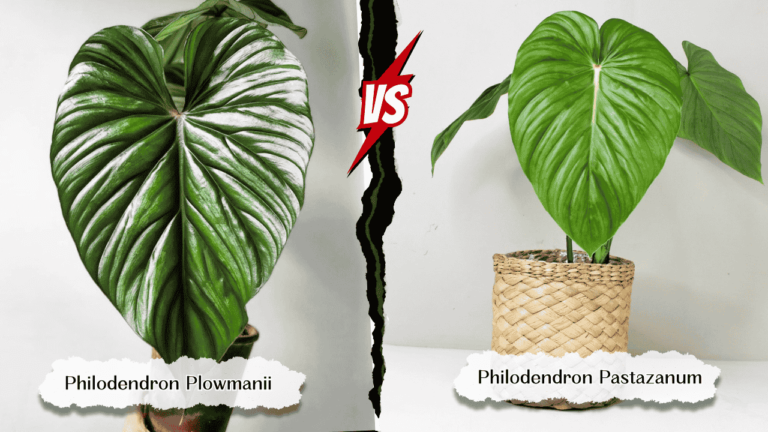Philo Heterocraspedon vs Patriciae: Differ these expensive drama queens
Philodendron Heterocraspedon and Patriciae – these names might sound like tongue twisters, but they represent two of the most coveted and elusive Philodendrons in the plant world. If you’re a serious plant collector, you’ve probably dreamt of adding one (or both!) of these rare beauties to your collection.
But let’s be honest, choosing between them can feel like navigating a dense jungle of information, with their similarities and subtle differences leaving you scratching your head. Fear not, fellow plant enthusiast!
We’re here to guide you through this verdant maze, shedding light on the unique characteristics and care needs of each plant. By the end of this journey, you’ll be armed with the knowledge to make an informed choice and bring a touch of the extraordinary into your home.
Heterocraspedon vs. Patriciae: Can You Tell Them Apart?
At first glance, these two Philodendrons might seem like long-lost siblings, separated at birth in the depths of the rainforest. But look closer, and you’ll start to notice subtle differences that set them apart. Let’s break down their key features side-by-side:
| Feature | Philodendron Heterocraspedon | Philodendron Patriciae |
| Leaf Shape | Elongated, oval to lance-shaped with wavy margins | Large, deeply pinnatifid with long, narrow lobes |
| Leaf Color | Deep green with a satin sheen | Deep green with a velvety texture |
| Petiole | Long, green, and smooth | Long, reddish, and slightly hairy |
| Stem | Green, sometimes with reddish hues | Thick, reddish-brown, often with aerial roots |
| New Leaf Color | Light green | Bronze or reddish |
| Growth Habit | Climbing or epiphytic | Climbing |
| Soil | Well-draining aroid mix | Well-draining aroid mix with added organic matter |
| Temperature | 65-80°F (18-27°C) | 65-80°F (18-27°C) |
| Humidity | High (70-90%) | High (70-90%) |
| Light | Bright, indirect light | Bright, indirect light |
| Water | Water when the top few inches of soil are dry | Water when the top few inches of soil are dry |
| Fertilizer | Fertilize monthly during the growing season with a diluted liquid fertilizer | Fertilize monthly during the growing season with a diluted liquid fertilizer |
| Common Pests & Diseases | Spider mites, mealybugs, scale, root rot | Spider mites, mealybugs, scale, root rot |
| Propagation | Stem cuttings | Stem cuttings |
| Toxicity | Toxic to pets and humans if ingested | Toxic to pets and humans if ingested |
| Rarity & Price | Extremely rare, very expensive | Extremely rare, very expensive |
Unraveling Their Roots: A Look at Their Origins
Understanding a plant’s natural habitat is like peeking into its past, giving us valuable insights into its care preferences.
- Philodendron Heterocraspedon: This elusive beauty hails from the remote rainforests of Colombia and Ecuador. Imagine it clinging to trees, its leaves catching the filtered sunlight and mist from the canopy. To keep it happy indoors, you’ll need to recreate these conditions with bright, indirect light, high humidity, and a well-draining potting mix.
- Philodendron Patriciae: This majestic plant is native to the rainforests of Colombia. It’s a true climber, reaching for the sky with its long, elegant leaves. Like Heterocraspedon, it thrives in high humidity and bright, indirect light.
Philodendron Heterocraspedon vs. Patriciae: Leaf by Leaf Visual Guide
Identifying these two Philodendrons is like solving a botanical puzzle. The leaves hold the key!
- Shape: Heterocraspedon leaves are elongated and oval to lance-shaped with wavy margins. Patriciae leaves are large and deeply pinnatifid, with long, narrow lobes that give them a feathery appearance.
- Color and Texture: Both plants have deep green leaves, but Heterocraspedon’s leaves have a satin sheen, while Patriciae’s leaves have a velvety texture.
- New Leaf Color: Heterocraspedon unfurls new leaves in a light green shade, while Patriciae’s new growth often emerges in a dramatic bronze or reddish hue.
Stems and Petioles: The Supporting Cast
Don’t underestimate the importance of stems and petioles! They play a vital role in distinguishing these two plants.
- Heterocraspedon: Long, green petioles support the elongated leaves. The stems are green, sometimes with reddish hues, and may develop aerial roots as the plant matures.
- Patriciae: Long, reddish petioles covered in fine hairs create a striking contrast with the deep green leaves. The stems are thick and reddish-brown, often adorned with aerial roots that help the plant climb.
Growth Habits and Care: Nurturing Your Rare Gems
Both Heterocraspedon and Patriciae are relatively slow growers, but they have distinct growth habits and require specific care to thrive.
- Growth Pattern: Heterocraspedon can be either a climber or an epiphyte (a plant that grows on another plant for support). Patriciae is a climber, reaching for the sky with its long, elegant leaves.
- Light: Both plants prefer bright, indirect light. Avoid direct sunlight, which can scorch their leaves.
- Water: Water when the top few inches of soil are dry. Allow excess water to drain to prevent root rot.
- Soil: A well-draining aroid mix is essential for both plants. Patriciae appreciates some added organic matter, such as coco coir or compost, to mimic its forest floor habitat.
- Humidity: Both plants crave high humidity (70-90%). Misting, pebble trays, or a humidifier are essential to create a suitable environment.
- Temperature: Both plants prefer warm temperatures between 65-80°F. Avoid cold drafts and sudden temperature changes.
- Fertilizer: Fertilize monthly during the growing season (spring and summer) with a diluted liquid fertilizer.
- Pruning: Prune regularly to maintain shape and encourage new growth. You can also propagate your plants from stem cuttings.
- Pests & Diseases: Keep an eye out for common pests like spider mites, mealybugs, and scale. Treat infestations promptly with insecticidal soap or neem oil. Root rot can be a problem if the soil is kept too wet. Ensure proper drainage and avoid overwatering.
FAQs: Philodendron Heterocraspedon vs. Patriciae
Which plant is rarer, philodendron heterocraspedon vs. patriciae?
Both plants are extremely rare and highly sought after by collectors.
Can I grow these plants in low light?
No, both plants require bright, indirect light to thrive. Low light will result in leggy growth and smaller leaves.
How often should I repot my Philodendron?
Repot every 1-2 years in the spring or summer when the plant becomes rootbound.
Why are the leaves on my Philodendron turning yellow?
Yellowing leaves can be a sign of overwatering, underwatering, or nutrient deficiencies. Check the soil moisture and adjust your watering accordingly. You may also need to fertilize your plant.
Can I propagate these plants from leaf cuttings?
No, Philodendrons cannot be propagated from leaf cuttings. You’ll need to take stem cuttings with at least one node.
Are these plants toxic to pets?
Yes, both Heterocraspedon and Patriciae are toxic to pets if ingested. Keep them out of reach of curious cats and dogs.
How do I clean the leaves of my Philodendron?
Gently wipe the leaves with a damp cloth to remove dust and grime. Avoid using harsh chemicals or leaf shine products.
Why is my Philodendron leggy?
Leggy growth is often a sign of insufficient light. Move your plant to a brighter location.
Can I train my Philodendron to climb?
Yes, both plants can be trained to climb a moss pole or trellis. Gently tie the stems to the support as they grow.
Where can I buy Philodendron Heterocraspedon and Patriciae?
These plants are extremely rare and can be challenging to find. You may be able to find them at specialty plant shops, online retailers, or through rare plant groups and communities. Be prepared to pay a premium price for these coveted plants.
Choosing Your Botanical Masterpiece
Philodendron Heterocraspedon vs. Patriciae? Which one will you choose? Choosing between Philodendron Heterocraspedon and Patriciae is like choosing between two rare diamonds. Both plants offer unique beauty and a touch of the exotic.
If you’re a dedicated collector seeking a truly exceptional plant with unique foliage and an air of mystery, Heterocraspedon might be the crown jewel of your collection. If you’re drawn to the elegance of deeply lobed leaves and a slightly more forgiving nature, Patriciae could be the perfect addition to your plant family.
No matter which plants you choose, remember that both Heterocraspedon and Patricia are living treasures from the rainforest. With patience, dedication, and a touch of horticultural know-how, they will thrive in your home, transforming your space into a lush, tropical sanctuary.




